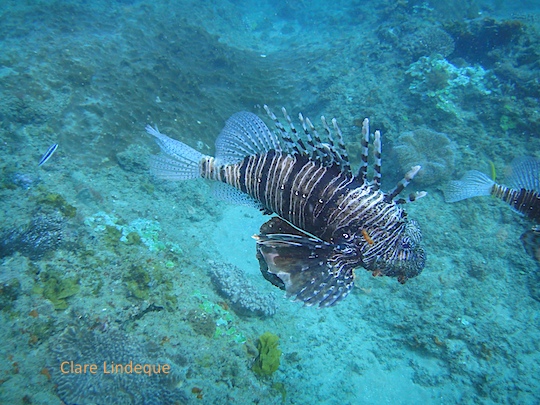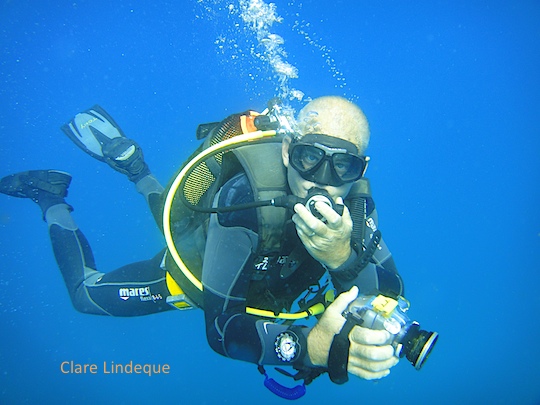
Doodles is the so-called “house Reef” of Ponta do Ouro. It’s a short boat ride from the corner of the beach where the dive boats launch, and we did three dives there on three different days. These dives were among the most exciting dives of my life – the first time we visited the reef, I felt after ten minutes that I was breathing so much that I’d be out of air in no time.

The depth ranges from 15-17 metres, and the reef has surprisingly little coral. It’s an irregularly-shaped rocky outcrop with plenty of crevasses and small caves in which we found black cheek moray eels, boxer shrimp, paper fish, and resting devil fire fish. Most of the action, however, seemed to be above the reef, where huge schools of maasbanker, dusky sweeper and yellow and blue banded snapper moved around and between each other like so many cars on an intricate network of invisible highways. At times, when we were swimming underneath the maasbanker, it actually got dark as the dense school of silvery fish blocked out the light.

We saw three large potato bass – one who has only one eye, one who is mostly white with large dark spots, and a third of average (for a potato bass) appearance – who moved among the smaller fish and occasionally lunged at them in a desultory manner, clearing a path for themselves. Seeing one of these enormous, gentle fish appearing behind the maasbanker and coming in for a visit was wonderful. They seemed to be constantly circling the outside of the reef, like traffic marshalls or bouncers.


Doodles is also home to several kinds of ray, and we saw so many of them on our dives there that after a while I started to feel a bit jaded about stingrays. Can you imagine? (The ingratitude!) My favourite was a honeycomb ray, whose tail seemed to be nearly two metres long. We spent quite a lot of time watching remoras trying to attach themselves to various round ribbontail rays. These little fish are very persistent and seemed to irritate the rays. I think their task of finding a place to hold on was complicated by the fact that they were trying to attach to the top of the ray, and hence had to swim upside down (their suction pad is on the top of their heads).

On our second dive at Doodles, we were buzzed a few times in rapid succession by a leopard (zebra) shark (Stegostoma fasciatum), an absoulutely beautiful creature that I initially mistook for some kind of thresher shark because of the shape of his tail. The visibility wasn’t ideal, but he passed by several times, complete with attached remora, swimming remora, and a small school of fish sheltering under his belly. Somehow they managed to keep track of his rapid changes of direction. The shark looked as though he was put together from distinct plates with ridges between them, and you can see the spots on his body in the pictures. He’s got really small eyes and a small mouth. These sharks are typically nocturnal (and completely non-threatening to humans) so we were very grateful to have seen him. There’s another photo of him and his entourage here.

The visibility ranged from 15 metres down to about 6 metres on the last day – related, I think, to the spring tides that occurred just before our arrival. As Capetonians, 6 metre visibility makes for an acceptable dive. When it’s combined with a veritable soup of fish, corals and beautiful topography, we’re quite happy.

Dive date: 8, 10, 11 May 2012
Air temperature: 24 degrees
Water temperature: 25 degrees
Maximum depth: 17.3 metres
Visibility: 6-15 metres
Dive duration: 58, 58, 61 minutes


























